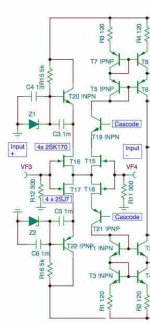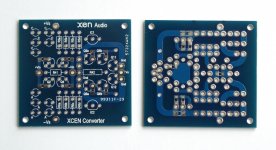If that is the argument then the audio world will only have LM3875's and opamps.
And they cal also sound very nice, as our own ES9022 modules showed.
But as Joachim said, this is philosophy, and a lot more fun.
Have you heard an audio chain with no global loop feedback at all ?

Patrick
And they cal also sound very nice, as our own ES9022 modules showed.
But as Joachim said, this is philosophy, and a lot more fun.
Have you heard an audio chain with no global loop feedback at all ?
Patrick
Hi,
so far I´m perfectly happy with the 4391s, especially in cascode with the lownoise BF862 and more so the LSK389C. The latter makes matching and output DC-blocking nearly obsolete (apart from some really ´off´ 4391s). Noise is no issue here. Unfortunately only N-channels and quite critical against oscillation in a modulated CS-loaded-source-follower fashion. So one better sticks to the simple CCS-loaded cascoded-Source-followers, even if that means less drive capability of 1xId.
jauu
Calvin
so far I´m perfectly happy with the 4391s, especially in cascode with the lownoise BF862 and more so the LSK389C. The latter makes matching and output DC-blocking nearly obsolete (apart from some really ´off´ 4391s). Noise is no issue here. Unfortunately only N-channels and quite critical against oscillation in a modulated CS-loaded-source-follower fashion. So one better sticks to the simple CCS-loaded cascoded-Source-followers, even if that means less drive capability of 1xId.
jauu
Calvin
Last edited:
Except for the nuisance of the extra required voltage, I concur on the 4391-like parts as cascode devices with the lower-voltage shorter-channel families like the 2SK170, BF862, et al. The drain-gate breakdown of the 4391 is also usually much higher than the guaranteed spec, which tempts one to madness, although for anything production-worthy one must stick to the guarantees.Hi,
so far I´m perfectly happy with the 4391s, especially in cascode with the lownoise BF862 and more so the LSK389C. The latter makes matching and output DC-blocking nearly obsolete (apart from some really ´off´ 4391s). Noise is no issue here. Unfortunately only N-channels and quite critical against oscillation in a modulated CS-loaded-source-follower fashion. So one better sticks to the simple CCS-loaded cascoded-Source-followers, even if that means less drive capability of 1xId.
jauu
Calvin
For still-higher output impedance, an iterated cascode with additional devices works, with even more of a voltage drop penalty, and the need for some floating gate bias. It's usually not necessary
BTW Walt Jung is working on presenting some history of JFET cascodes and has dug up some details on pioneers of the technique, so I shall say no more about the probable first uses of the technique. However, the principle is clearly along the lines of the first use of the bootstrapped cascode using bipolars by Aldridge; and the effectiveness in the FET case, besides the increase in low-frequency output impedance, is particularly due to the pumping of the output drain-gate displacement current back into the lower JFET source. This is only effective when there is substantial Z in the source compared to the reciprocal transconductance, so that most of the current flows in the source.
This is approximately the input stage of the bespoke phono.
The problem is not new to me and this is a topology that can be used more universal.
So when the request came up to make a simple Bal-Umbal converter i already had a solution. I used current mirrors though.
The problem is not new to me and this is a topology that can be used more universal.
So when the request came up to make a simple Bal-Umbal converter i already had a solution. I used current mirrors though.
Attachments
I do mostly mirrors. MiiB, Sigurd and i have researched them now to a point where they virtually introduce no distortion. It is more complex then a cascode Widlar or Wilson though.
I use folded cascodes too but instead of the drain resistors i use constant current sources.
They have their problems too like noise but that can also be solved. One of the reasons i went so far with mirrors is that the folded cascode is very well researched and we have
very good and mature examples like the Blowtorch. I simply wanted to try something new. Driven cascodes are also very interesting and i found new ways to implement them. Lets see what will happen in the future. Electronics design is certainly still moving
forward.
I use folded cascodes too but instead of the drain resistors i use constant current sources.
They have their problems too like noise but that can also be solved. One of the reasons i went so far with mirrors is that the folded cascode is very well researched and we have
very good and mature examples like the Blowtorch. I simply wanted to try something new. Driven cascodes are also very interesting and i found new ways to implement them. Lets see what will happen in the future. Electronics design is certainly still moving
forward.
- Home
- Source & Line
- Analog Line Level
- The XCEN -- Balanced to Single Ended Converter

